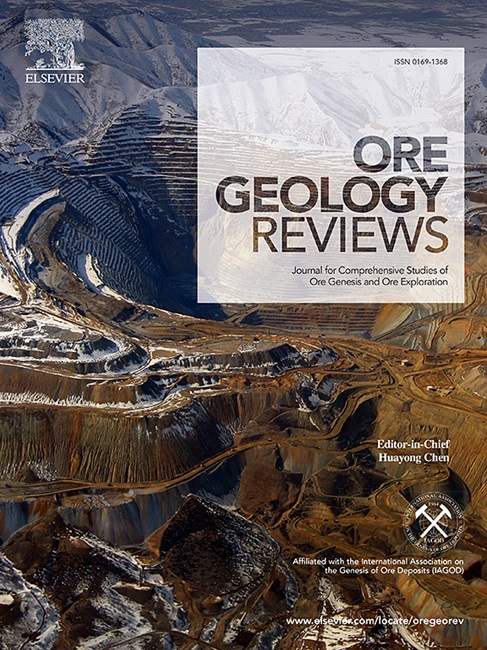西藏拉康锷斑岩型钼铜矿床硫化物微量元素和硫同位素原位分析及其成矿流体演化指示
IF 3.6
2区 地球科学
Q1 GEOLOGY
引用次数: 0
摘要
拉康峨铜钼矿床是藏南冈底斯成矿带中以钼为主的斑岩矿床,该区以甲玛、曲隆等铜为主斑岩矿床而闻名。岩浆-热液演化对成矿流体发育的影响尚未得到系统的研究,从而限制了我们对整个成矿带铜钼矿化成因联系的认识。本研究通过对不同阶段(A、B1、B2、D)热液脉中黄铁矿、黄铜矿和辉钼矿S同位素和微量元素的原位分析,反映了热液系统在S源、温度、pH和氧化还原条件等方面的演化过程,解决了这一问题。硫化物δ34SCDT值总体变化范围(-7.68‰~ +0.75‰),且各阶段间缺乏系统变化,表明硫化物的岩浆源一致。黄铁矿中Co/Ni比值从A、B1脉向B2、D脉下降,整体呈冷却趋势。A和B1矿脉中硫化物中砷含量升高且方解石缺乏,而D和B2矿脉中硫化物中砷含量相对较低且方解石存在,表明流体从早期到晚期酸性减弱。与A、D脉相比,B1、B2脉黄铁矿中Te含量相对较高,说明B1、B2脉形成于相对还原条件下,而A、D脉形成于相对氧化条件下。A脉中大量磁铁矿析出导致Fe3+的消耗可能是导致fO2降低的原因,导致B1脉中Mo矿化明显。随着热液系统的持续演化,温度的降低和大气水流入的增加,fO2再次增加,促进了D脉中黄铁矿-黄铜矿的析出,而不是辉钼矿。最后,另一阶段明显的钼矿化可能是由构造再激活引起的休眠岩浆房中残余含金属流体的释放引发的,这些含金属流体随后向上迁移形成B2脉。本文重点研究了岩浆热液流体在拉康峨钼铜矿床形成过程中的动态演化过程,并论证了流体温度、氧逸度(fO2)和大气水的参与是成矿作用的主要控制因素。B1和B2矿脉中辉钼矿的析出受温度降低和fO2的驱动,而D矿脉中黄铜矿的析出受大气水混合导致的流体冷却的驱动。在冈底斯成矿带内的其他铜钼矿床中也可能发生过这种岩浆-热液动力学作用,表明铜钼矿床中也可能发育过单独的钼成矿期。本文章由计算机程序翻译,如有差异,请以英文原文为准。

In-situ trace element and sulfur isotope analyses of sulfides as indicators of ore-forming fluid evolution in the Lakang’e porphyry Mo-Cu deposit, Tibet, China
The Lakang’e Mo-Cu deposit is a Mo-dominated porphyry deposit located in the Gangdese metallogenic belt of southern Tibet, which is known for Cu-dominated porphyry deposits such as Jiama and Qulong. The magmatic-hydrothermal evolution responsible for the development of ore-forming fluids in this deposit has not been systematically examined, thus limiting our understanding of the genetic link between Cu and Mo mineralization throughout the metallogenic belt. This study addresses this problem through in-situ analysis of S isotopes and trace elements of pyrite, chalcopyrite and molybdenite from hydrothermal veins of different stages (A, B1, B2, D), which reflect the evolution of the hydrothermal system in terms of S source and temperature, pH and redox condition. The overall range of δ34SCDT values (–7.68 ‰ to +0.75 ‰) of the sulfides and the lack of systematic variation from one stage to another are consistent with a common magmatic source for the sulfur. The decrease of Co/Ni ratios in pyrite from A and B1 to B2 and D veins indicates an overall cooling trend. The elevated As concentrations in sulfides and the lack of calcite in A and B1 veins versus the relatively low As in sulfides and presence of calcite in the D and B2 veins suggest that the fluids became less acidic from early to late stages. The relatively elevated Te concentration in pyrite in B1 and B2 veins compared to those in A and D veins suggests that B1 and B2 veins formed under relatively reducing conditions, whereas A and D veins formed under relatively oxidizing conditions. The consumption of Fe3+ due to precipitation of large amounts of magnetite in A vein may be responsible for the decrease in fO2, which induced significant Mo mineralization in B1 veins. As the hydrothermal system continued to evolve with decreasing temperature and increasing influx of meteoric water, the fO2 increased again, which promoted the precipitation of pyrite-chalcopyrite instead of molybdenite in the D veins. At last, another phase of distinct Mo mineralization may have been triggered by the release of residual metalliferous fluids from a dormant magma chamber due to tectonic reactivation, subsequently migrating upward and forming the B2 veins. Our study highlights the dynamic evolution of magmatic-hydrothermal fluids during the formation of the Lakang’e Mo–Cu deposit and demonstrates that fluid temperature, oxygen fugacity (fO2), and the involvement of meteoric water were the primary controls on mineralization. Molybdenite precipitation in the B1 and B2 veins was driven by decreasing temperature and fO2, whereas chalcopyrite precipitation in the D vein was triggered by fluid cooling due to mixing with meteoric water. Such dynamic magmatic-hydrothermal processes may have also operated in other Cu-Mo deposits within the Gangdese metallogenic belt, implying that separate episodes of Mo-dominated mineralization may have been potentially developed in the Cu-dominated deposits as well.
求助全文
通过发布文献求助,成功后即可免费获取论文全文。
去求助
来源期刊

Ore Geology Reviews
地学-地质学
CiteScore
6.50
自引率
27.30%
发文量
546
审稿时长
22.9 weeks
期刊介绍:
Ore Geology Reviews aims to familiarize all earth scientists with recent advances in a number of interconnected disciplines related to the study of, and search for, ore deposits. The reviews range from brief to longer contributions, but the journal preferentially publishes manuscripts that fill the niche between the commonly shorter journal articles and the comprehensive book coverages, and thus has a special appeal to many authors and readers.
 求助内容:
求助内容: 应助结果提醒方式:
应助结果提醒方式:


